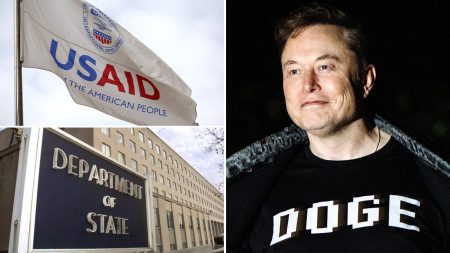The sudden collapse of Bashar al-Assad’s regime in Syria, after years of brutal civil war, has created a chaotic power vacuum, with various factions, both internal and external, scrambling to secure their interests and potentially seize control of the fractured nation. This volatile situation presents a complex geopolitical puzzle, with interwoven alliances and rivalries, creating a breeding ground for further conflict and instability. The United States, while welcoming Assad’s downfall, is primarily focused on containing the resurgence of ISIS, conducting airstrikes against the terrorist group amidst the unfolding chaos. Simultaneously, Turkey, a NATO ally of the US, continues its offensive against US-backed Kurdish forces in northern Syria, adding another layer of complexity to the already tangled web of alliances and conflicts.
Hayat Tahrir al-Sham (HTS), an Islamist militant group, spearheaded the final offensive against Assad, capturing Damascus and forcing the dictator to flee. While HTS’s victory marks a significant turning point in the Syrian conflict, their ascendance presents a new set of challenges. Designated a terrorist organization by the UN, US, and Turkey, HTS’s ultimate goal is to establish an Islamic emirate in Syria. Despite recent attempts to soften their image and portray themselves as providers of governance and protectors of religious sites, their extremist ideology and past affiliation with al-Qaeda raise serious concerns about the future of Syria under their potential rule. Turkey’s suspected involvement in HTS’s offensive further complicates the situation, highlighting the intricate and often conflicting interests at play in the region.
The remnants of Assad’s forces, though significantly weakened, remain a factor in the ongoing struggle for power. After years of relying on support from Russia, Iran, and Hezbollah, the Syrian army’s rapid collapse underscores the fragility of Assad’s grip on power. HTS’s offer of amnesty to conscripted soldiers suggests a pragmatic approach to consolidating control and minimizing further bloodshed. However, the long-term implications of integrating former regime forces into a potential HTS-led government remain uncertain, given the stark ideological differences.
The Syrian National Army (SNA), a coalition of Turkish-backed rebel groups, played a role in Assad’s downfall, further demonstrating Turkey’s multifaceted involvement in the Syrian conflict. While primarily focused on combating Kurdish forces, the SNA’s participation in the final offensive against Assad highlights their opportunistic nature and willingness to shift alliances based on evolving circumstances. Turkey’s long-standing animosity towards the Kurds, whom they view as an extension of the PKK, a designated terrorist organization, fuels their continued military operations in northern Syria, creating friction with the US, who support the Kurdish-led Syrian Democratic Forces (SDF).
The SDF, a crucial US partner in the fight against ISIS, has largely remained on the sidelines of the recent offensive against Assad, focusing on consolidating their control in northeastern Syria and defending against Turkish attacks. While welcoming Assad’s downfall, the SDF faces an uncertain future in a post-Assad Syria, particularly given Turkey’s continued hostility and the potential rise of HTS. Their precarious position underscores the challenges of balancing alliances and pursuing their own aspirations for autonomy in a region rife with competing interests.
The international dimension of the Syrian conflict further complicates the already intricate landscape. Russia, a long-time ally of Assad, has granted him asylum, signaling a strategic retreat from its previous commitment to propping up his regime. The ongoing war in Ukraine has likely strained Russia’s resources and diverted its attention away from Syria. Similarly, Iran, another key supporter of Assad, has seen its influence diminish due to Hezbollah’s redeployment to Lebanon to address escalating tensions with Israel. These shifts in regional power dynamics have created an opportunity for other actors, such as Turkey and HTS, to assert themselves and reshape the future of Syria.
Israel, a regional power with a vested interest in containing Iranian influence, has seized the opportunity presented by Assad’s fall to further its own security objectives. By striking Assad’s chemical weapons facilities and securing a buffer zone in the Golan Heights, Israel aims to mitigate potential threats and prevent the transfer of sensitive materials to hostile groups. Their actions reflect a proactive approach to safeguarding their borders and maintaining regional stability in the wake of Assad’s demise. The United States, while committed to preventing an ISIS resurgence, faces a difficult balancing act in navigating the complex web of alliances and rivalries in Syria. Their continued support for the SDF, despite Turkey’s objections, underscores the delicate nature of their relationships in the region. The fall of Assad presents both an opportunity and a challenge for the US, as they grapple with the potential for renewed instability and the need to prevent the emergence of new extremist threats.










